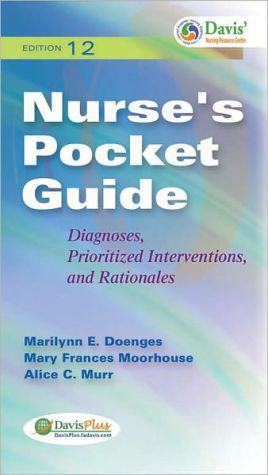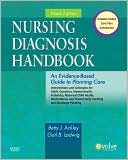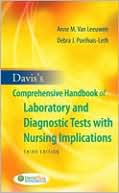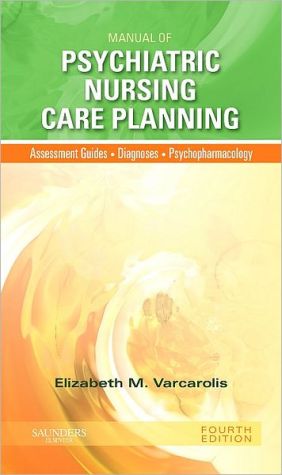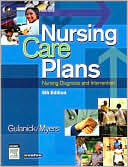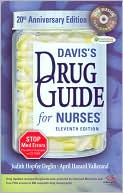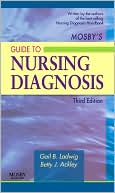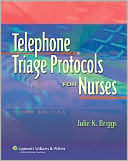Nurse's Pocket Guide: Diagnoses, Prioritized Interventions and Rationales
This pocket size portable reference is the perfect tool for you to use to select the appropriate diagnosis to plan your patient s care effectively. The 12th Edition features the latest nursing diagnoses and updated interventions. And, Davis s Nursing
Search in google:
This pocket size portable reference is the perfect tool for you to use to select the appropriate diagnosis to plan your patient care effectively. The 12th Edition features the latest nursing diagnoses and updated interventions. And, Davis Nursing Diagnosis and Care Planning Resource Center online features a searchable database with 800 diagnoses plus a wealth of clinical tools and valuable information. Doody Review Services Reviewer:Carole A. Kenner, RNC, DNS, FAAN (University of Oklahoma College of Nursing) Description:This text is designed as a quick resource for identifying nursing internations associated with NANDA International diagnoses. The book uses symbols to guide the user in identifying interventions that are collaborative, community based, life-span, medication related and cultural considerations.Purpose:The book's purpose is to provide a ready to use format to assist practicing and student nurses with care planning. It links interventions with NANDA International approved nursing diagnoses. This purpose is according to the author and reviewer. These are worthy objectives and are met.Audience:The intended audience is practicing nurses and students. This is according to the author and reviewer. The authors are well known, highly credible nursing leaders.Features:The book begins with an overview of the nursing process, examples of assessment tools, sample care plans, mind maps, and documentation. There is a chapter devoted to special populations issues that strengths and broadens the book's appeal. The use of symbols throughout the text guides the user in recognizing cultural, life-span, community/home health, medication, diagnostic tests, and special population aspects of care planning. These are a good teaching tool for the user to also identify collaborative care problems. It is noted by the authors that obstetrical, gynecologic, and pediatric problems are considered for the most part outside the scope of this text. This is a shortcoming as these areas of nursing are present in the community as well as acute caresettings.Assessment:This is a 10th edition with the last one published in 2004. This edition addresses the changes from a North American NANDA to an International one and includes the new Taxonomy II classifications-more than justifying a new edition. The book and its earlier editions have been well accepted in nursing circles. This pocket guide is linked with other major comprehensive works by the same authors in nursing care planning and thus provides an excellent suite of products. No other similar text provides the same linkages with related products.
How to Use this Nurse’s Pocket Guide\ \ The Nursing Process\ Application of the Nursing Process\ Putting Theory into Practice: Sample Assessment Tools, Plan of Care, Mind Mapping, and Documentation\ \ \ \ Assessment Tools for Choosing Nursing Diagnosis\ Diagnostic Divisions: Nursing Diagnoses Organized According to a Nursing Focus\ Client Situation and Prototype Plan of Care\ Documentation Techniques: SOAP and Focus Charting®\ \ \ \ \ Nursing Diagnosis in Alphabetical Order\ Health Conditions and Client Concerns with Associated Nursing Diagnoses\ \ \ \ Appendices\ 1. NANDA’s Taxonomy\ 2. Definitions of Taxonomy II Axes
\ Reviewer:Carole A. Kenner, RNC, DNS, FAAN (University of Oklahoma College of Nursing) \ Description:This text is designed as a quick resource for identifying nursing internations associated with NANDA International diagnoses. The book uses symbols to guide the user in identifying interventions that are collaborative, community based, life-span, medication related and cultural considerations.\ Purpose:The book's purpose is to provide a ready to use format to assist practicing and student nurses with care planning. It links interventions with NANDA International approved nursing diagnoses. This purpose is according to the author and reviewer. These are worthy objectives and are met.\ Audience:The intended audience is practicing nurses and students. This is according to the author and reviewer. The authors are well known, highly credible nursing leaders.\ Features:The book begins with an overview of the nursing process, examples of assessment tools, sample care plans, mind maps, and documentation. There is a chapter devoted to special populations issues that strengths and broadens the book's appeal. The use of symbols throughout the text guides the user in recognizing cultural, life-span, community/home health, medication, diagnostic tests, and special population aspects of care planning. These are a good teaching tool for the user to also identify collaborative care problems. It is noted by the authors that obstetrical, gynecologic, and pediatric problems are considered for the most part outside the scope of this text. This is a shortcoming as these areas of nursing are present in the community as well as acute caresettings.\ Assessment:This is a 10th edition with the last one published in 2004. This edition addresses the changes from a North American NANDA to an International one and includes the new Taxonomy II classifications-more than justifying a new edition. The book and its earlier editions have been well accepted in nursing circles. This pocket guide is linked with other major comprehensive works by the same authors in nursing care planning and thus provides an excellent suite of products. No other similar text provides the same linkages with related products.\ \
